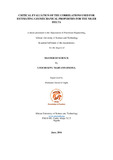| dc.contributor.author | Uzorchukwu, MaryAnn | |
| dc.date.accessioned | 2017-09-07T15:41:29Z | |
| dc.date.available | 2017-09-07T15:41:29Z | |
| dc.date.issued | 2016-06-16 | |
| dc.identifier.uri | http://repository.aust.edu.ng:8080/xmlui/handle/123456789/618 | |
| dc.description.abstract | The study area which is the Niger Delta Province is predominantly an unconsolidated sandstone terrain, the sand grains are friable suggesting the expectation of some geomechanical problems while developing hydrocarbon reserves in such terrain. In this study, the geomechanical property used to measure rock strength (i.e. unconfined compressive strength) was evaluated by using three principal methods. Critical drawdown pressure (CDP) and sand production rate were also evaluated. Firstly, the use of statistical analysis, secondly, these statistical parameters were combined into a single parameter called rank using the Multiple Statistical Optimization Model. Finally, performance plots of the measured geophysical log and estimated values of the unconfined compressive strength were made to confirm the results of the statistical and ranking methods. The database consists of forty-three (43) data points obtained from well D4 in the Niger Delta terrain. The best correlation for the Niger Delta reservoir is the Sharma and Singh (2008) correlation. It has a rank of 27.11, and the lowest percentage absolute error (Ea.) of 13.94 which was the best when compared to other correlations evaluated. It had the best performance plot for UCS≤ 75 Mpa and favourably predicted the critical drawdown pressure with 7% deviation from measured CDP. It is recommended to be used in situations where core samples of UCS are not available for the Niger Delta reservoirs as well as other regions of the world where the formation is similar to that of the Niger Delta. Two wells G-14 and G-15 were evaluated for sand production in this study. The product of their shear modulus and the bulk modulus at all depths considered was less than the threshold value of 8E11psi 2 ; this suggests the possibility of formation failure in the production life of the reservoir. The possibility of sanding was confirmed by their loading factor value of 2.0 and 2.35 respectively, for well G-14 and G-15. The sand production rates for the two wells show only an average maximum deviation of 5% in all cases investigated but this was below the tolerance of 10% deviation suggested by the model used. | en_US |
| dc.description.sponsorship | AUST,ADB. | en_US |
| dc.language.iso | en | en_US |
| dc.subject | Uzorchukwu MaryAnn | en_US |
| dc.subject | Prof David Ogbe | en_US |
| dc.subject | 2016 Petroleum Engineering theses | en_US |
| dc.subject | Geomechanical properties | en_US |
| dc.subject | Unconfined compressive strength | en_US |
| dc.subject | Statistical parameters | en_US |
| dc.subject | Critical drawdown pressure | en_US |
| dc.subject | Loading factor | en_US |
| dc.subject | Sand production rate | en_US |
| dc.title | Critical Evaluation of the Correlations used for Estimating Geomechanical Properties for the Niger Delta | en_US |
| dc.type | Thesis | en_US |

